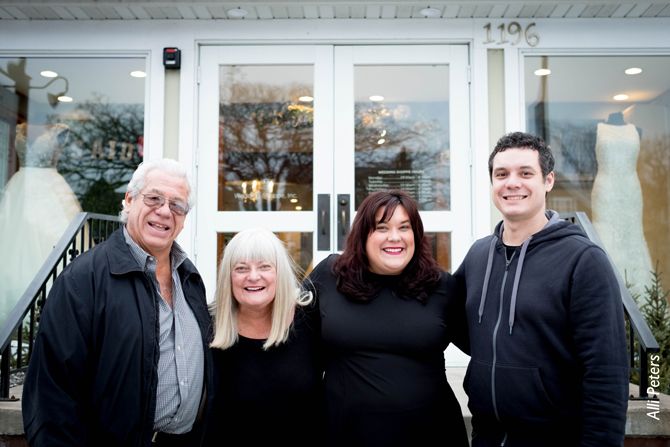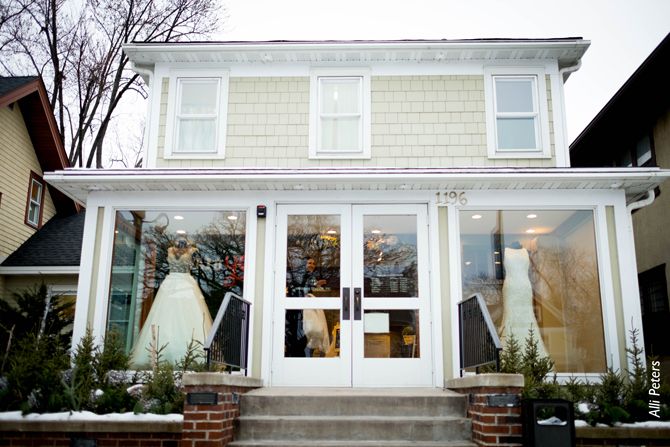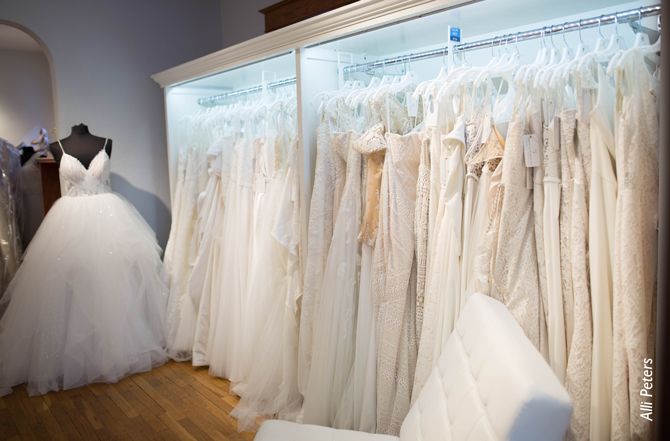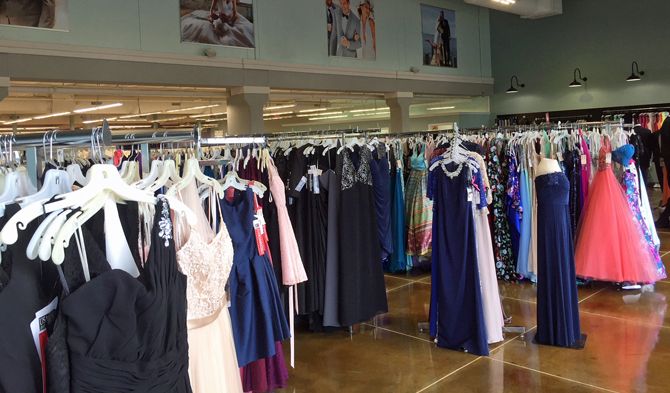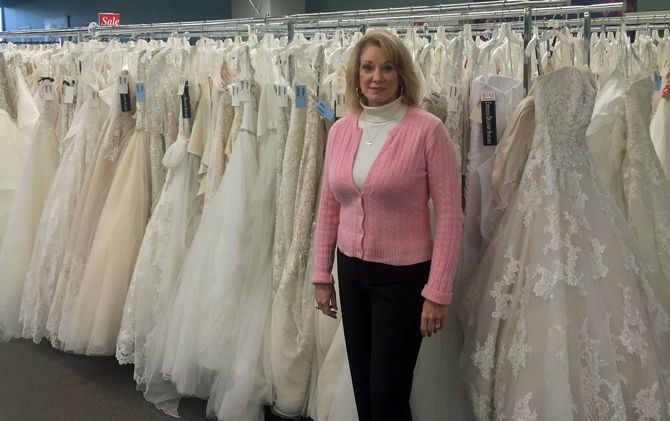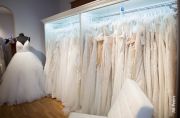When Jim and Lois Fritz opened the Wedding Shoppe in St. Paul, Minn., in 1977, the couple could have never predicted the sweeping changes that would hit the bridal industry over the next four decades.
Back then, of course, the Internet had yet to overrun the Earth and Amazon was – first and foremost – a massive South American rainforest, not a U.S. retail behemoth altering some of the most rooted consumer habits. Much as the idea of a reality television series that followed women selecting their wedding gowns seemed improbable, so, too, did the thought of selling products to distant customers without seeing a face, hearing a voice or otherwise having any direct interaction. Back in 1977, that seemed the stuff of Ray Bradbury science fiction.
Today, however, it’s reality and there’s even a term for it: omnichannel, the complementary blend of a physical storefront with an e-commerce presence.
The new omnichannel world is something the Wedding Shoppe, now under the charge of second-generation owner Jim Fritz, Jim and Lois’ son, has been forced to master.
In the fall of 2007, Fritz began building an online store for the Wedding Shoppe. For the previous 30 years, the Wedding Shoppe operated much like every other independent bridal store in America: it welcomed brides into its physical storefront and introduced a range of wedding gowns fitting a client’s style and budget.
But the younger Fritz, about the same age as many of the brides his store catered to, saw an opportunity to push the Wedding Shoppe in new directions. Noting how many brides researched wedding dresses online, he bet that full transparency – sharing information on styles, colors, prices and more – would drive attention and sales, both with local brides and those from afar.
“From my perspective as a consumer, it made sense that people would want to go in educated before making a purchase like this,” Fritz says. “After 30 years of everything existing behind our walls, I decided to go the opposite direction and be completely transparent.”
In the still early days of e-commerce – Amazon’s annual revenue in 2007, for example, was less than one-tenth of what it is today – Fritz’s move represented a bold, daring play, particularly in a bridal industry slow to change. Fritz says many vendors were hesitant to play along. So, too, were customers. In fact, when the Wedding Shoppe launched its online store in January 2009, Fritz patiently waited for the first sale to arrive. And the wait got uncomfortably long.
“It was scary,” Fritz said during a March 19 phone call with VOWS. “We devoted all of this money and time to establishing the online store and nothing. To say it was concerning would be an understatement.”
But as online sales crawled at the Wedding Shoppe, store appointment bookings and in-store sales accelerated at a rather rapid clip. In erasing the unknowns about the products inside the Wedding Shoppe, Fritz had successfully shifted perception of the store, one located in an affluent area of St. Paul. The bet on transparency proved successful.
“People thought our dresses were expensive because of where we were,” Fritz says. “By getting our catalog online with prices and designs, we eliminated the unknowns and more brides came to us.”
In time, the online sales came, too, and the Wedding Shoppe of 2018 isn’t what it was a decade ago, let alone 41 years ago when Fritz’s parents opened the doors. The Wedding Shoppe now fills multiple buildings, covering some 25,000 square feet with retail space, warehousing and offices, while also maintaining its own line of bridal attire, Kennedy Blue. Though brick-and-mortar sales dominate the store’s overall revenue pie, with about 80 percent of sales arriving from in-store purchases, Fritz’s omnichannel play has boosted the Wedding Shoppe, transforming in-store and online results as consumer habits have evolved.
“As I see it,” Fritz begins, “there are two kinds of bridal shoppers: those who want the full-fledged princess experience in-store – and many of those women are still going to shop and do research online – and another segment that doesn’t really care and is only interested in the best, most efficient way to buy. If you want to connect with customers today, I think you have to be omnichannel and serving both. If not, you better be doubling down on an over-the-top in-store experience or catering to a very defined niche.”
Unlocking the benefits of an omnichannel world
In today’s retail climate, many retail insiders consider it important, if not downright necessary, that bridal stores adopt the “bricks-and-clicks” omnichannel model. By complementing a physical location with an online commerce platform, stores better position themselves to satisfy the expectations of contemporary consumers.
“Omnichannel is really about being where your customers are,” says Stephen Meserve, senior product marketing manager at BigCommerce, a leading e-commerce platform. “If you’re going to get discovered, then you need to expand beyond brick-and-mortar and be present on multiple sales channels.”
Jay Motwani, director of sales at Volusion, another top e-commerce platform, says the ability to reach a larger audience remains omnichannel’s most compelling advantage. With a brick-and-mortar store alone, bridal shops are largely limited to servicing those within a reasonable driving distance during the store’s normal operating hours. In adopting the omnichannel approach, however, stores are open 24/7, enticing visits, if not direct sales, by displaying available products.
“This all helps employees be more efficient and customers be more aware and, without it, the store needs to provide so much more value to attract customers,” says Motwani, adding that an online store can also help a retail operation test potential new products before making a heftier investment.
The promise of attracting a bigger audience, scoring sales and wooing brides into the store by sharing plenty of concrete information in advance of their visit continues driving the omnichannel efforts of Blush Bridal in Fayetteville, N.C. Blush Bridal opened its store in a downtown Fayetteville home in 2014, six months after launching its online business from a local office and studio.
“We wanted to serve brides shopping the same ways we do and saw few bridal shops doing that,” co-owner Faith Anderson says.
At its online store, Blush Bridal shares information on approximately 3,000 wedding dresses, about a third of which are available for sale. (By contrast, the store’s in-stock bridal inventory tops out at roughly 500 dresses.) Many brides discover Blush Bridal’s website first and then book an appointment online, most visiting the store from within a three-hour radius. In complementing Blush Bridal’s brick-and-mortar storefront with an energized online store, Anderson says the business has capitalized on most brides’ commitment to research, which is arguably as prevalent in bridal as any other retail category. In addition to its wedding gowns, Blush Bridal’s online store also features t-shirts, emergency kits, veils and footwear with online sales representing about 30 percent of the company’s overall revenue.
“Before our brides come in, they have a chance to see all the products we have in advance and that clarifies the whole process,” Anderson says. “I think [having the online store] gives us a bigger reach than other stores with a basic website, enhances our credibility and helps us reach those tech-savvy customers accustomed to shopping and ordering online.”
This isn’t to suggest, however, that bridal shops should ditch their physical storefronts in favor of a wholly online model. In fact, the omnichannel approach rejects such siloed functions and champions blending both the physical and the digital. For many, omnichannel represents not the sign of a retail apocalypse – as some have suggested with the continued rise of e-commerce – but rather a retail renaissance challenging stores to refine who they are and how they serve their customers.
Though most brides research online and some will purchase online, for instance, the vast majority still purchase their gowns inside a brick-and-mortar store, especially given the expense of the item, the fitting process and, not to be understated, the emotion and sentimentality often attached to the wedding dress. Such realities continue making a brick-and-mortar presence a necessity in bridal in a way it might not be in other highly commoditized retail categories such as office supplies, books or toys.
Furthermore, it’s worth noting that many bridal stores with an online store report capturing many of their Internet sales not from bridal gowns, but rather bridesmaids, accessories, prom and other non-bridal gown categories. USA Bridal, a 30-year business with four stores in Tennessee and Kentucky and a robust online presence, says online sales represent 1 percent of overall company revenue, and bridal gowns are only a fraction of that tiny figure.
“From the bridal side, the real benefit [of the omnichannel approach] isn’t necessarily the direct online sales, but in having local brides use the website as a pre-shopping tool,” USA Bridal CEO Bobbie Crabtree says. “It’s comfortable for brides to get on our site, bookmark items and then come into our store aware of styles and prices.”
Any direct sales from USA Bridal’s online store, Crabtree adds, is the proverbial icing on the cake.
“If I sell four dresses online, those are sales I wouldn’t have likely gotten otherwise,” she says.
The omnichannel world of challenges
Yet, capturing the benefits of omnichannel retailing, especially for those hoping to secure direct online sales, arrives with its share of costs and complexity.
First, and critically important for any bridal store considering the omnichannel approach, building and maintaining a vibrant online store requires a sizable investment of time, energy and money. If you elect to produce a custom design, the costs for set up and ongoing maintenance can quickly run into five figures.
John Frew of Frew’s Bridal in Alton, Ill., the independent bridal store behind the 17-year-old BestBridalPrices.com website, estimates he has spent “millions” on the website since its 2001 launch.
“The servers alone run $3,000 each month,” Frew notes.
Fritz, meanwhile, calls running an online store “vastly more complicated” than it was a decade ago when he brought the Wedding Shoppe online. Then, he says, retailers could make money simply by having an e-commerce platform. Today, however, there’s much more to understand from the technical, marketing and manufacturing side. In the last two years, Fritz, who spends “a lot of time in the weeds” himself, hired an in-house developer and has worked to integrate communication between the Wedding Shoppe’s website and its point-of-sale system.
“This is a long, expensive process and things are changing so fast that it can eat you up in terms of expenses,” Fritz says.
On the plus side, there has been a continued easing of the costs and complexity with out-of-the-box e-commerce solutions such as BigCommerce, Volusion and Shopify. Using such resources washes away talk of servers and IT and can help retailers launch an online store more economically and efficiently than ever before. BigCommerce, for example, has some e-store plans for less than $100 a month, while Volusion’s monthly plans range from $15-135.
You can start with a theme and then customize the template to match your individual brand. Thereafter, you can add products and establish payments and fulfillment functionalities.
“Retailers can invest a few hours each week and get a decent e-commerce presence going in a few weeks,” Motwani says.
Over the last decade, about 200 bridal retailers have turned to eStyleCentral.com to enter the e-commerce game. The platform allows select retailers to tap into ready-built digital inventories of popular bridal designers. Retailers on the platform, for instance, can identify each of the designers they carry and develop an online store listing not only the specific dresses, including size and color, they currently hold in their physical stock, but also entire catalogs from their vendors. The eStyleCentral.com platform handles the entire back end, including the time-consuming process of uploading and updating product content.
“Stores comes to us when they want the entire collections they have access to perpetually updated,” eStyleCentral.com founder Sal Macaluso says.
The eStyleCentral.com platform integrates with point-of-sale systems such as BBL, P&B Systems’ FormalWare and Bridal Web Solutions. For the full eStyleCentral.com program, retailers pay a one-time $5,500 set-up fee and a locked-in monthly rate of $575, though some stores, Macaluso notes, are eligible for discounts.
“If a customer is ultimately going to buy online, then this functionality helps us get you into her consideration set,” Macaluso says.
Crabtree, who has been using eStyleCentral.com for more than a decade, says subscribing to the eStyleCentral.com platform has made it easier for USA Bridal to be an online retailer and embrace the omnichannel approach.
“If we didn’t use a service like this, it’d be tough because it’s time-consuming and expensive to build and maintain an online store,” she says.
But the work – and expense – doesn’t stop at initial set-up as online stores require constant attention to remain relevant and current. Most notably, you will need to regularly update products on the site, a substantial charge given the constant coming and going of many bridal products.
“Allure alone has more than 500 products to build,” Frew says. “So as a small store, you have to ask yourself if you have the time to input and then manage all of this?”
Though Anderson largely produced Blush Bridal’s web store herself, she also hired personnel to do product loading. Careful as she and others have been, Anderson confesses she has spent significant time over the years correcting errors and updating product. In other efforts to keep Blush Bridal’s web store relevant, lively and fresh, Anderson has also shifted templates, changed the way customers can sort through dresses and added dropdowns to navigation.
“It’s a time-consuming experience running an online store,” Anderson confirms.
Once comfortable, confident and – hopefully – generating revenue with a basic online store, retailers often then layer on more advanced e-commerce functionalities, such as an e-mail marketing plan, live chat functionality or linking e-commerce to social-media sites such as Pinterest or Instagram.
“This isn’t as much about having a plan to go online, because that’s imperative in today’s retail world, but rather how in-depth you want to go and how close to perfection you want to get,” Motwani says.
For some, simply having an online catalog and providing information on in-stock dresses will be enough. For others, showcasing the full array of dresses a store has access to and capturing as many online sales as possible is the target. Either way, it’s an investment of precious resources.
“Retailers will need to have a vision for what they want to accomplish and that includes defining their needs and wants as well as the value proposition they’re providing by going online,” Meserve says. “You can’t go into this lightly because [running an online store] can be a real detractor for the business if you don’t know the challenges it can bring.”
Another critical challenge bridal stores must consider, especially if direct sales are a prominent goal: mounting competition. Many well-heeled enterprises from Nordstrom and Anthropologie to private equity-funded startups and international players – some legitimate and some less than pristine – have committed themselves to the bridal channel and building inroads into a large and profitable field, often doing so with some hefty resources or key marketplace advantages at their disposal.
“No matter what, we’re still a small business operating a big website and these are our competitors,” Blush Bridal’s Anderson reminds.
The rise of international players has been a particular challenge for Frew. At one time, Frew says online sales represented 95 percent of the company’s overall revenue – and that was with a relatively healthy brick-and-mortar presence. Today, the ratio has completely flipped as online sales have dwindled. Frew attributes the drastic shift to customers moving downstream to lower-priced product – much of it from overseas suppliers – that was not previously available.
“That’s been a drag that’s made online far from what it once was,” Frew says.
As a result, Frew largely uses his online store today at local bridal shows, where he and staff can highlight available styles and check inventory. While Frew continues investing in BestBridalPrices.com, he’s simultaneously doubling down on the foundation of Frew’s Bridal: its Alton, Ill., storefront and staff.
“I got into e-commerce at a great time, but all good things don’t last,” Frew says. “I think it’s important to have a web presence today, but I’m not so sure that needs to be an e-commerce presence. You could be committing yourself to a costly and unproductive venture if you insist on chasing those online sales in a saturated market in which every corner is covered.”
At the Wedding Shoppe, Fritz similarly notes the challenge of competitive pricing, though he holds more optimism than Frew. In fact, Fritz believes online sales could someday represent half of the Wedding Shoppe’s overall revenues, largely because of KennedyBlue.com, the Wedding Shoppe’s own line of bridesmaids dresses that run $150 or less. Having economical, exclusive products has positioned the Wedding Shoppe to compete more effectively in a charged marketplace and Fritz anticipates launching additional proprietary lines in the near future.
“My whole thing is that we need to be prepared to compete because there’s a lot of money getting thrown at this target,” Fritz says. “I sympathize with retailers trying to figure this out today because it is so much more competitive today than when we started more than a decade ago. Still, it’s a puzzle that retailers need to put together.”

Going Omnichannel
The perks and perils of adopting a brick-and-click approach.

